#oregon geology
Text

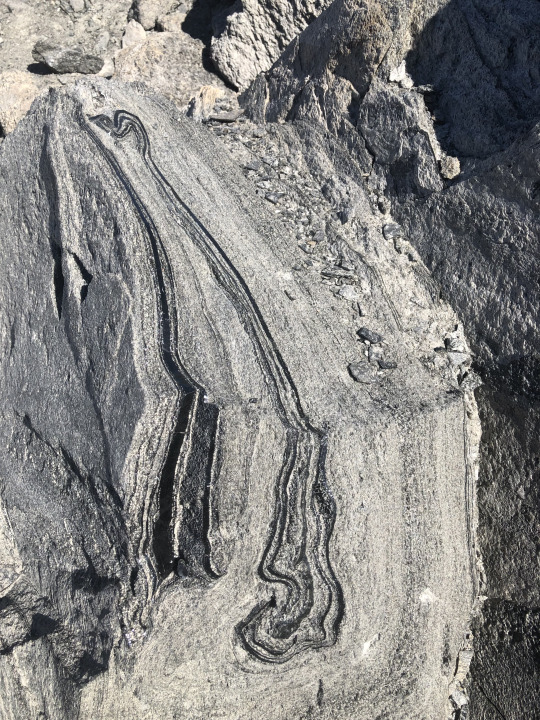
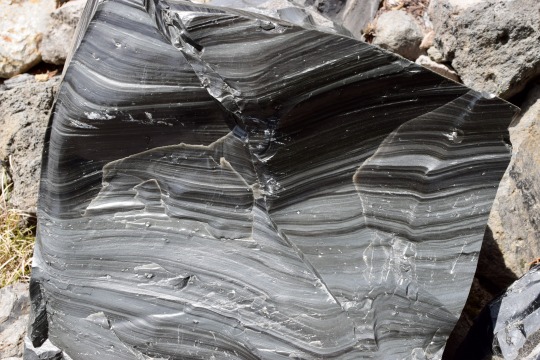
The Big Obsidian Flow is the youngest lava flow in Oregon, at the juvenescent age of ~1,300 years before present. It's a product of the most recent eruption of Newberry Volcano, the largest in the Cascade Range north of the California border (Medicine Lake Volcano is the largest overall). Newberry is a bit enigmatic - it's a huge volcano with a high rate of large eruptions but is not on the main Cascade volcanic arc. There's a number of converging fault zones in this area, which probably create significant crustal weakness allowing magma to percolate through the crust quickly.
Obsidian is common in lava flows of the rhyolitic composition, which is the most evolved kind of magma. Rhyolite magma spends lots of time spent in the crust for crustal rocks to contaminate the magma body and for heavier iron/magnesium-rich minerals to settle out, leaving behind a melt with over 68% silica (quartz). Silica is the same stuff regular glass is made of, so the higher your silica content then the glassier your lava flow is likely to be on the surface. The bands present in big chunks of obsidian are the result of shearing, differential cooling/composition, and flowing during the lava flow. This is very thick, sticky, viscous lava that doesn't like to flow. As it cools, it breaks rather than bends and turns the lava flow into a moonscape of glass shards and boulders.
The large amount of obsidian at this and other flows around Newberry Volcano is interesting because the volcano is mostly made of basalt - a lava with a near-opposite composition from rhyolite. Akin to Mauna Loa or Iceland, most of Newberry's lava flows form a broad shield more than 60 miles N-S and 30 miles E-W (roughly 100x50 km). The central part of the Volcano is about ten miles (16 km) across and contains a caldera formed when the central summit collapsed ~75,000 years ago. The caldera has been filled by subsequent eruptions and by two lakes separated by a big pumice cone. This means that the volcano produces - simultaneously - a wide range of magma compositions, indicating a complicated and long-lived magmatic system. Hazards from Newberry (to the 200,000 people living on its slopes) are not limited to fluid basalt eruptions that slowly blanket the landscape but also major explosive eruptions. The Big Obsidian Flow is a representative of the latter. Ash and debris from that eruption is found as far away as Idaho, and is many meters deep near the eruption's vent.
#oregon geology#geology#lava#magma#obsidian#volcano#volcanology#newberry volcano#central oregon#bendoregon#Cascade Volcanoes#PNW Volcano#rocks#oregon
159 notes
·
View notes
Text
Does anyone want to see my favorite caldera


Mount Mazama erupted around 7700 years ago and then collapsed, and as a result, we now have Crater Lake
#caldera#geology#volcano#oregon#its 6 miles wide#sorry i had to fix the post bc i fucked it up the first time#anyway i took these sunday!!#i havent been there in 24 years or so?
110 notes
·
View notes
Text

Jagged
What do you think about my pic?
#Mt Bailey#Mount Bailey#shield volcano#Cascade Range#Oregon#Pacific Northwest#travel#original photography#vacation#tourist attraction#landmark#landscape#countryside#forest#woods#summer 2023#geology#rocks#nature#flora#photo of the day#Douglas County
21 notes
·
View notes
Text

It’s Tell a Friend Friday!
Please enjoy this photo I took of Wy'east (Mt. Hood) a few years ago on a backpacking trip on Section G of the Pacific Crest Trail.
Then tell someone you know about my work–you can reblog this post, or send it to someone you think may be interested in my natural history writing, classes, and tours, as well as my upcoming book, The Everyday Naturalist. Here’s where I can be found online:
Website - http://www.rebeccalexa.com
Rebecca Lexa, Naturalist Facebook Page – https://www.facebook.com/rebeccalexanaturalist
Tumblr Profile – http://rebeccathenaturalist.tumblr.com
BlueSky Profile - https://bsky.app/profile/rebeccanaturalist.bsky.social
Twitter Profile – http://www.twitter.com/rebecca_lexa
Instagram Profile – https://www.instagram.com/rebeccathenaturalist/
LinkedIn Profile – http://www.linkedin.com/in/rebeccalexanaturalist
iNaturalist Profile – https://www.inaturalist.org/people/rebeccalexa
Finally, if you like what I’m doing here, you can give me a tip at http://ko-fi.com/rebeccathenaturalist
#Wy'east#Mt. Hood#Oregon#Pacific Northwest#PNW#backpacking#through hiking#hiking#nature#nature photography#mountain#Cascade Mountains#landscape#landscape photography#Tell a Friend Friday#volcano#geology#PCT#Pacific Crest Trail
20 notes
·
View notes
Text
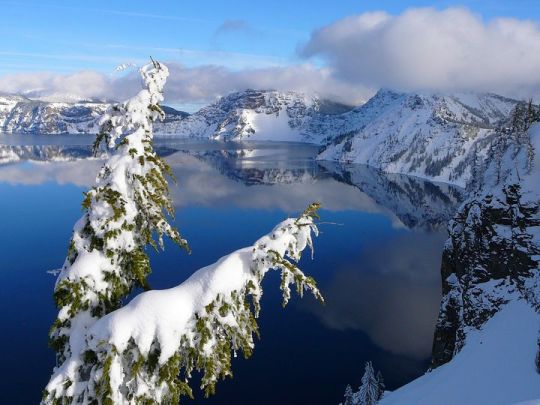
Crater Lake inspires awe.
Fed by rain and snow, it’s the deepest lake in the United States and one of the cleanest and clearest lakes in the world.
There is no better time to witness Crater Lake National Park’s beauty than in the winter. With an average of more than 500 inches of snow a year, Crater Lake offers terrific opportunities for winter recreation.
via: U.S. Department of the Interior
18 notes
·
View notes
Photo
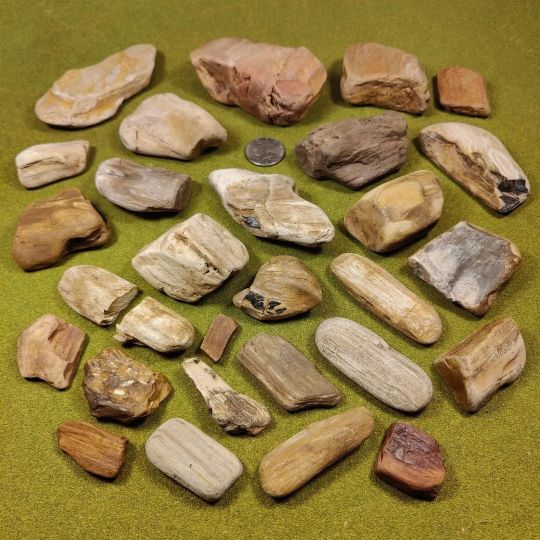
Petrified wood from the Willamette River, same trip as last post. Some excellent grain and optimistic agate cores in this bunch. I've already sliced up one of these pieces, and it's sick #rock #rocks #silica #rockhounding #oregon #rockhound #geology #agate #agates #quartz #crystal #zeolites #mineral #minerals #collection #earth #geo #nature #pnw #pacificnorthwest #mining #digging #wood #petrifiedwood #fossil #fossils #fossilwood #woodgrain (at Bar Mavin) https://www.instagram.com/p/Cl0DGp0uKO6/?igshid=NGJjMDIxMWI=
#rock#rocks#silica#rockhounding#oregon#rockhound#geology#agate#agates#quartz#crystal#zeolites#mineral#minerals#collection#earth#geo#nature#pnw#pacificnorthwest#mining#digging#wood#petrifiedwood#fossil#fossils#fossilwood#woodgrain
106 notes
·
View notes
Text
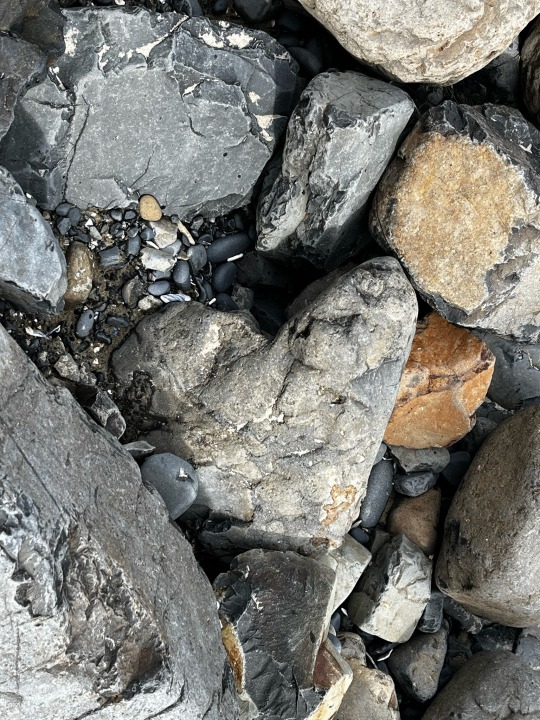
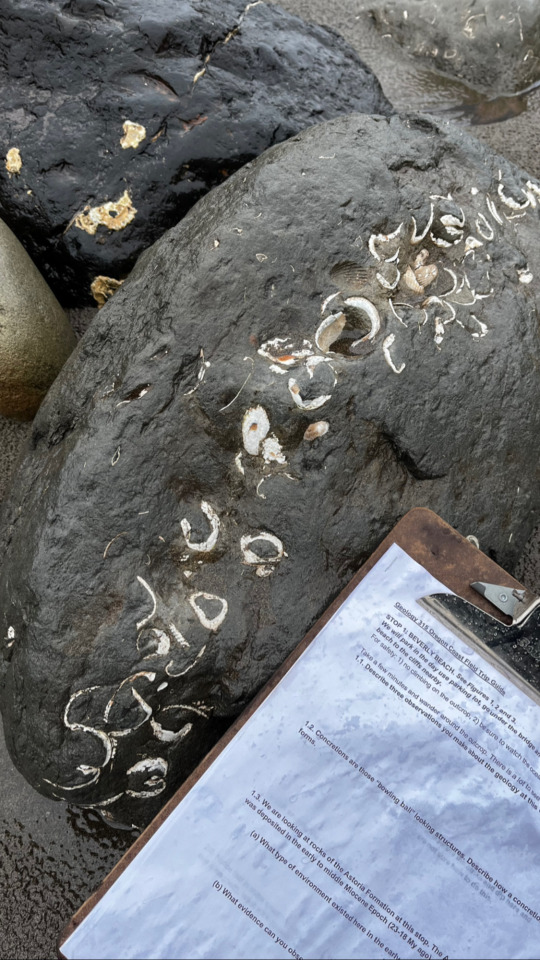
had a field trip this weekend to the coast ⚒️
53 notes
·
View notes
Text
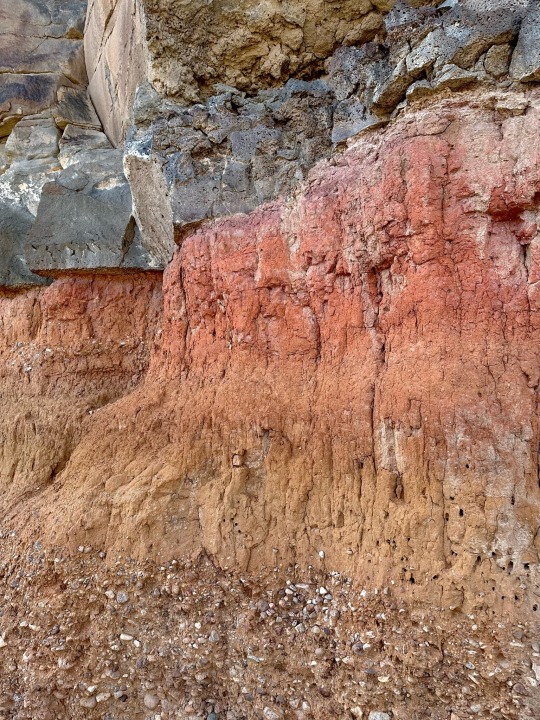
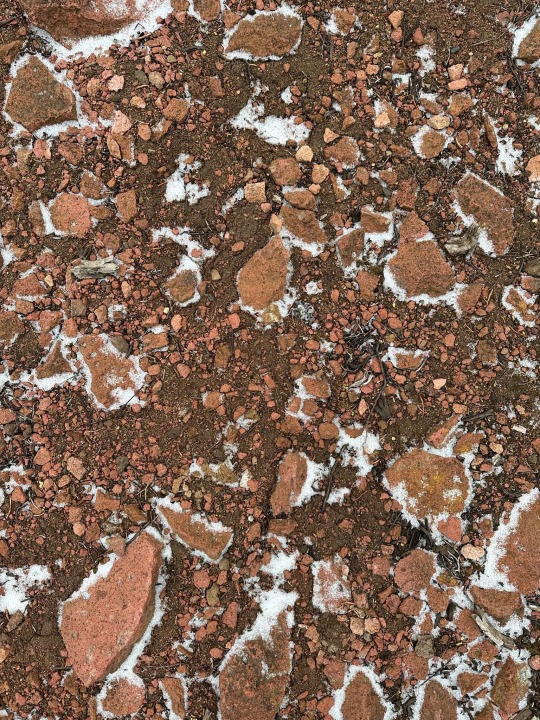

Winter 2024 - earth is pink
3 notes
·
View notes
Text
Life from a rock’s perspective
3 notes
·
View notes
Text
geology prof liked my historical and literary references in my field report. said it was new and refreshing, really made my report stand out.
we went to the oregon coast.
i quoted dune.
#academic equivalent to being praised for adding oregano to pasta#like yes#of course its there#why wouldnt it be there#dune was entirely inspired by the oregon coast#specifically its geology#aaaaaaaaaa
13 notes
·
View notes
Text
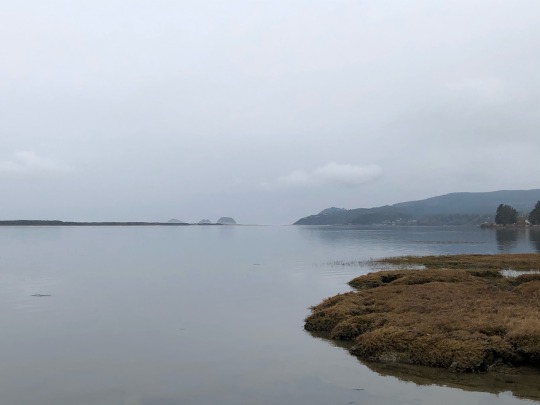
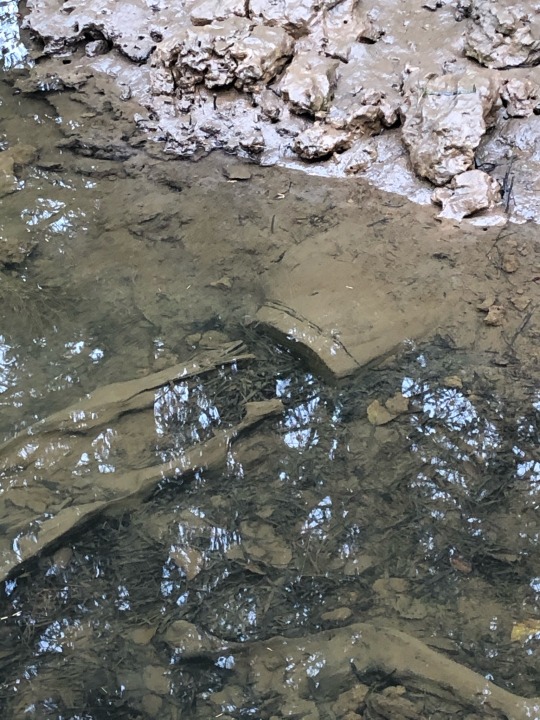

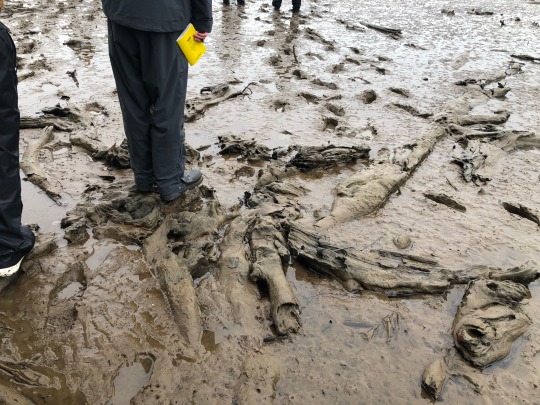
Netarts Bay is home to one of the finest estuaries in Oregon; a rich ecosystem of oysterbeds and coastal marshes. However, it conceals evidence of the last great earthquake in the Northwest. 320 years ago, on January 26, 1700, the Cascadia Subduction Zone ruptured along its full length, sending a colossal tsunami onto the Oregon Coast and across the Pacific to Japan. The tsunami is recorded in Oregon as a layer of sand amidst mudflat deposits. Here, 7 tsunami layers are recorded, showing earthquakes back over 2,000 years.
Also, a ghost forest is present. Stumps of ash and fir trees are preserved under water and in the mud that have been carbon dated to around 1000AD. These trees were killed by a tsunami event which saturated them in salt water. The earthquakes cause the coast to subside by about 1 meter, into the water, and the slow tectonic action between earthquakes slowly raises it back above the water.
I've been back a number of times since these pictures were taken, and when the data is all published I'll talk more freely about it.
#oregon geology#cascadia#geology#marine geology#ghost forest#netarts#oregon coast#paleoseismology#field work
90 notes
·
View notes
Text
The Cascade Range in western North America are a remarkably quiet volcanic chain. Even though potentially active volcanoes stretch from Lassen Peak in the south to Garibaldi in the north, the only volcano to erupt in the past century is Mount St. Helens (twice). That's it. Compare that to places like Japan, Kamchatka, Indonesia and other volcanic arcs where it isn't uncommon for multiple volcanoes to be popping off simultaneously, the Cascades feel downright silent.
This is why the volcanological community get excited when something, anything, happens. The something that has everyone's attention right now is the return of the "bulge" on the west side of South Sister, part of the Three Sisters volcanoes west of Bend in Oregon.
Now, all this doesn't mean the USGS Cascades Volcano Observatory thinks anything will happen soon ... or at all. They have not changed the alert status from "Green", the lowest level. Even if this is magma moving, we have little clue to whether it is enough to cause an eruption ... or if any eruption could happen in the next few years or next few centuries.
3 notes
·
View notes
Text

Full rainbow over the Columbia River Gorge ✨️ I felt so lucky to have seen this!
Photography by Haley Willner / Singulardreamscapes
#rainbow#double rainbow#columbia river gorge#oregon#pnwonderland#landscape lovers#bestnatureshot#scenery#seekmorewilderness#pacific northwest#haleywillnerphotography#nature#trees#upperleftusa#geology#geography
21 notes
·
View notes
Text
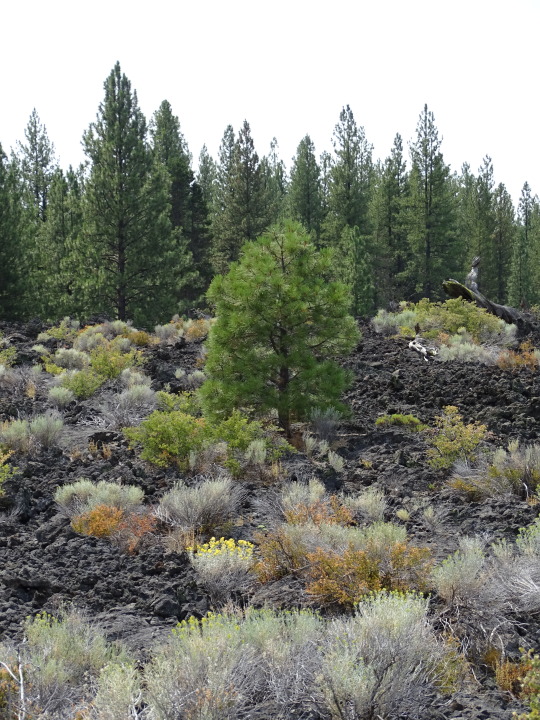
New Life
What do you think about my pic?
#Newberry National Volcanic Monument#Deschutes National Forest#travel#original photography#vacation#tourist attraction#landmark#landscape#countryside#geology#nature#flora#Deschutes County#USA#summer 2023#Oregon#Lava Flow#bush#tree#rock#Pacific Northwest#photo of the day#What do you think about my pic?#impressive landscape#grass#forest#fir#pine#woods
7 notes
·
View notes
Text

Hey! If you missed out on last week's PNW Geology class, I still have room in tonight's Ecoregions of Oregon class, which also has a lot of good information on geology in this region. I've already sent out class information so if you do sign up, drop me a line at rebeccathenaturalist(at)gmail(dot)com so I can get you the Zoom info.
Also, next week on the 16th I have my East Cascades Ecoregion course, which goes into more detail about the geology and biology of the Cascade Mountains' dry side.
Both classes are online and open to anyone! No prerequisites or STEM background required. You can register for either class at the links at https://rebeccalexa.com/class-schedule/
#geology#Pacific northwest#PNW#ecoregions#science#scicomm#science communication#STEM#Oregon#nature#natural history#Cascade Mountains#online classes#online learning#educational
22 notes
·
View notes
Text


lefa :)
(eocene, clarno formation, western us)
15 notes
·
View notes

